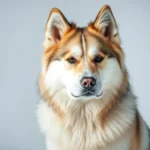
Introduction
Dog breeds are distinct categories of domesticated dogs, each with unique characteristics, behaviors, and purposes. Understanding different breeds is essential for potential dog owners, as it helps in selecting the right companion that fits their lifestyle and needs. Among the many breeds, the Lurcher stands out as a fascinating and versatile dog that has captured the hearts of many.
The Lurcher is not just a single breed but rather a hybrid that combines various breeds, most commonly Greyhounds and Collies. This mixed heritage gives Lurchers a unique blend of speed, agility, and intelligence. Historically bred for hunting, Lurchers have evolved into beloved companions, known for their affectionate nature and adaptability. In this article, we delve deep into the world of Lurchers, exploring their characteristics, history, and care requirements.
Understanding Dog Breeds
What is a Dog Breed?
A dog breed is defined as a specific group of domestic dogs that share common traits and characteristics, which are often passed down through generations. These traits can include physical attributes such as size, coat type, and color, as well as behavioral tendencies. Factors that influence the formation of dog breeds include genetics, environmental conditions, and selective breeding practices.
Categories of Dog Breeds
Dog breeds are typically categorized based on their primary functions and characteristics. Here’s a brief overview of the main categories:
- Working Dogs: Bred to perform specific tasks, such as guarding or pulling sleds.
- Herding Dogs: Developed for herding livestock and controlling animal movements.
- Sporting Dogs: These dogs assist hunters in retrieving game.
- Hound Dogs: Bred for hunting and tracking due to their keen senses.
- Terriers: Known for their feisty nature and originally bred for hunting vermin.
- Toy Dogs: Small breeds that are often companions.
- Non-Sporting Dogs: A diverse group that doesn’t fit into the other categories.
Lurchers occupy a unique niche within these categories, often falling under the hound classification due to their hunting background, while also sharing traits with working dogs.
The Lurcher: An Overview
What is a Lurcher?
A Lurcher is a hybrid breed that typically results from crossing a sighthound, like a Greyhound, with a working or herding breed, such as a Collie. This combination results in a dog that is not only fast and agile but also highly trainable and intelligent. Lurchers have a graceful appearance, often characterized by a slender build, long legs, and a deep chest, making them excellent runners.
History of the Lurcher
The history of the Lurcher dates back to the early 19th century in the United Kingdom. Originally, Lurchers were bred by poachers who sought to create a dog that could run swiftly and catch game. The blend of breeds allowed them to excel in hunting while also being adaptable to life as a family companion. Over the years, Lurchers have maintained their reputation as skilled hunters and loyal pets, often seen in rural areas where they continue to assist with hunting and tracking.
The influence of various breeds, particularly the Greyhound and Collie, has shaped the Lurcher into the versatile animal it is today. Their mixed heritage allows for a variety of sizes, coat types, and temperaments, making them an intriguing choice for many dog lovers.
Physical Characteristics of Lurchers
Size and Weight
Lurchers can vary significantly in size, typically standing between 24 to 28 inches tall at the shoulder and weighing anywhere from 45 to 75 pounds. This variability is largely due to their mixed breed nature, resulting in a range of sizes and body types. When compared to other breeds, Lurchers are generally taller and leaner, resembling their sighthound ancestors.
Coat and Color
Lurchers exhibit a diverse array of coat types, which can be short, long, rough, or smooth. The color patterns also vary widely, including solid colors, brindle, and spotted variations. Common colors include fawn, black, blue, and various shades of brown. This diversity in appearance is one of the many appealing aspects of owning a Lurcher.
Distinctive Features
Some distinctive physical features of Lurchers include a narrow head, long neck, and a streamlined body that contributes to their agility. Their long legs and strong muscles enable them to reach impressive speeds, making them exceptional runners. The variability within the breed often leads to unique combinations of traits, resulting in each Lurcher having its own distinct appearance.
Temperament and Behavior
General Temperament
The Lurcher is known for its gentle and affectionate nature. They tend to be friendly with both humans and other animals, making them great family pets. Despite their hunting background, Lurchers are usually calm and relaxed at home, enjoying the company of their human companions. They thrive on social interaction and can develop strong bonds with their families.
Energy Level and Activity Needs
Lurchers are high-energy dogs that require regular exercise to keep them healthy and happy. Daily walks, play sessions, and opportunities to run off-leash in safe environments are essential to meet their activity needs. Lurchers often enjoy games like fetch and agility training, which also stimulate their minds and provide valuable bonding time with their owners.
Training and Intelligence
Lurchers are known for their intelligence and trainability, making them relatively easy to train with consistent, positive reinforcement methods. Early socialization and obedience training are crucial to ensure they grow into well-rounded adult dogs. Common behavioral issues, such as chasing smaller animals or being overly excitable, can often be managed with proper training techniques and regular exercise.
Health and Care
Common Health Issues
Like many mixed breeds, Lurchers tend to be relatively healthy, but they can be prone to certain genetic conditions. Common health issues include hip dysplasia, bloat, and certain skin conditions. Regular veterinary check-ups can help catch any potential problems early, ensuring a longer, healthier life for your Lurcher. The average lifespan of a Lurcher is typically around 12 to 15 years.
Nutrition Requirements
A balanced diet is crucial for maintaining the health and energy levels of a Lurcher. High-quality dog food formulated for active breeds is recommended. It’s essential to consider their size, age, and activity level when determining portion sizes and feeding schedules. Typically, Lurchers do well on a diet rich in protein and healthy fats, which supports their energetic lifestyle.
Grooming Needs
Grooming requirements for Lurchers depend on their coat type. Short-haired Lurchers may require minimal grooming, while those with longer or rougher coats may need more frequent brushing to prevent matting. Regular baths, nail trimming, and dental care are also important components of their grooming routine.
Living with a Lurcher
Ideal Living Conditions
Lurchers can adapt well to various living conditions, but they thrive in homes with plenty of space to run and play. While they can be kept in urban settings, access to parks or open areas is beneficial. A secure yard is ideal for off-leash playtime, as Lurchers have a strong prey drive and may chase after smaller animals if given the opportunity.
Family Compatibility
Lurchers are known for their gentle demeanor, making them suitable for families with children. They generally have a calm disposition and can form close bonds with kids, often enjoying playtime and cuddling. Furthermore, Lurchers can coexist peacefully with other pets, especially if they are introduced at a young age or properly socialized.
Adoption and Buying a Lurcher
If you’re considering adding a Lurcher to your family, you have several options for adoption or purchase. Many Lurchers are available through shelters and rescue organizations, where you can find dogs in need of loving homes. If you choose to buy from a breeder, ensure they are reputable and prioritize the health and well-being of their dogs. Questions to ask before adopting or purchasing include inquiries about health testing, temperament, and the dog’s background.
Conclusion
In summary, the Lurcher is a unique and lovable breed that brings a wealth of joy to any household. With their gentle temperament, high energy levels, and adaptability, Lurchers make excellent companions for active families or individuals. Understanding their characteristics, health needs, and care requirements is essential for providing them with a happy and fulfilling life. If you are considering welcoming a Lurcher into your home, you are sure to find a loyal and affectionate friend who will enrich your life.
Additional Resources
Recommended Books and Websites
For those interested in learning more about dog breeds and Lurchers specifically, numerous books and online resources can provide valuable insights. Check local libraries or bookstores for titles focused on dog training, care, and breed-specific information.
Support Groups and Forums
Engaging with online communities or local clubs dedicated to Lurchers can be an excellent way to connect with other owners, share experiences, and gain support. Whether you’re looking for training tips or simply want to celebrate your love for Lurchers, these groups can provide a wealth of information.
Veterinary and Training Resources
When it comes to caring for your Lurcher, finding a veterinarian familiar with the breed is essential. Additionally, consider seeking professional trainers who specialize in Lurchers to ensure your dog receives the best guidance and support in their training journey.









